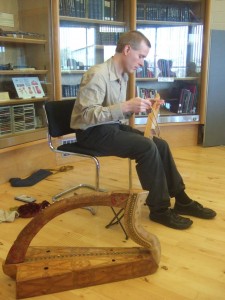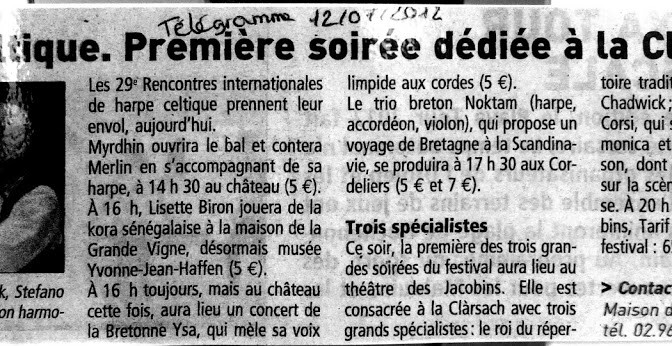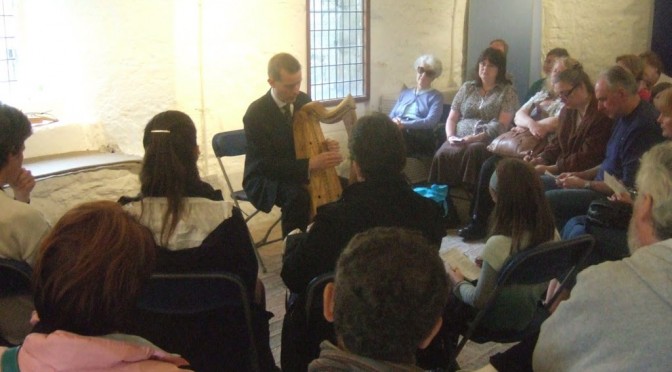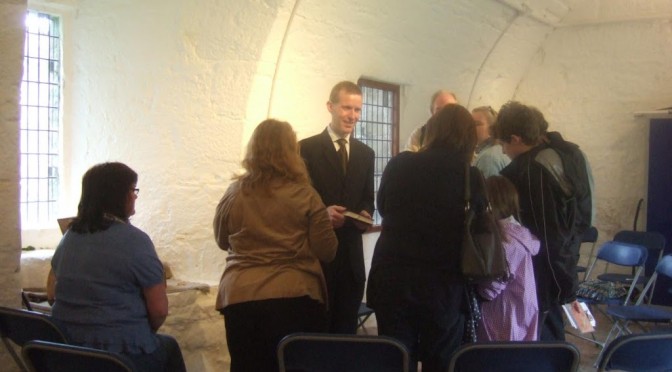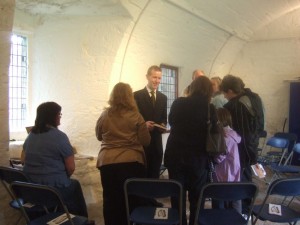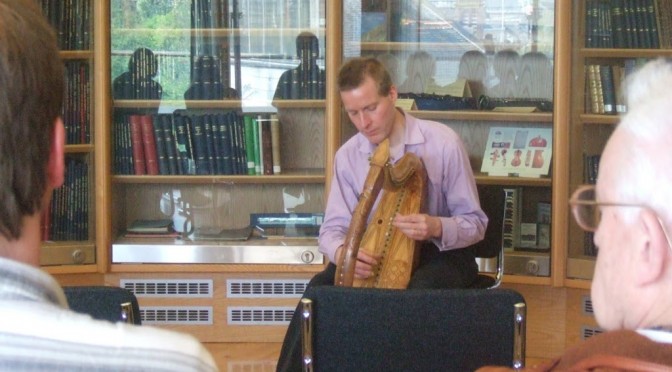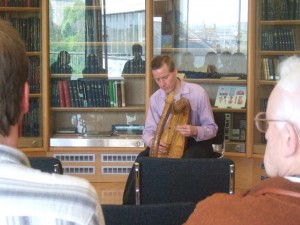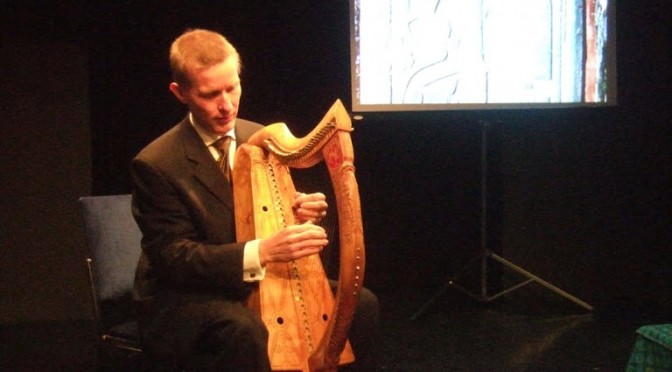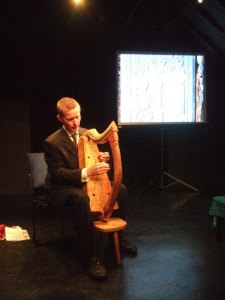Here’s a photo of me playing the jouhikko in my concert at lunchtime today in the Wighton Centre.
Tag: concert
Margaret 1281 concert in Dundee
On Wednesday lunchtime I’ll be presenting my Margaret 1281 programme in the Wighton Centre, in Dundee Central Library. This is always a fun event, the free concert run by the Friends of Wighton on the first Wednesday of every month at 1.15pm.
I presented this programme back in June at St Andrews Cathedral and it worked very well. The idea is to present a dramatic episode of Scottish history in music and verse. All of the six items on the programme have strong connections to Scotland or Norway in the late 1200s and early 1300s.
As well as playing the replica Queen Mary harp, I’ll sing the traditional ballad telling a part of this story, and I’ll also pull out the jouhikko for a bit of old Scandinavian flavour.
Botanic Baroque
On Saturday evening I will be at the botanic gardens here in St Andrews for an outside evening concert. I’ll have my 18th century Irish harp with me and will be playing a programme of “Carolan, Connellan & Lyons”.
The Downhill harp is loud and strident enough to work in an outdoors setting, and I am hoping that the elegant and sweet tunes from these three composers will complement the summer evening picnic ambience on the lawn of the gardens.
I am interested in these three composers as the finest exponents of the “Irish baroque”, a kind of fusion of the old native styles with the fashionable Italianate music that swept into Scotland and Ireland in the years around 1700.
In Ireland it was the harpers who embraced this new fashion, and Carolan and Lyons were right in there composing Italianate tunes or variation sets in full-on continental style, though always viewed through the prism of the old Gaelic performance traditions on the early Gaelic harp. Connellan, being that bit earlier, worked in a more traditional way though he can perhaps be seen as one of the earliest to compose the big 18th century irish “sean-nos” songs.
In Scotland, the few harpers that remained by 1700 did not engage with this Italian music fashion, and it was the fiddlers who were the most enthusiastic in developing the Scottish baroque style. James Oswald is perhaps the best known and most prolific, and I am using his delightful setting on one of Lyons’s tunes. Lyons called it “Miss Hamilton” after one of his patrons, but Oswald calls it “The blossom of the rasberry” which wonderfully fits our Botanic Garden theme. There is a lovely variation in Oswald’s set which may have come from Lyons but really sounds more like Oswald’s work.
Dinan
I am in Dinan, Brittany, for the harp festival. Last night I played with Ailie Robertson and Stefano Corsi at the big evening concert in the Theatre. This press cutting made me laugh: “le roi du répertoire traditionelle gaélique”
Today I have a “rencontre”, a kind of conversation – I am looking forward to this. And then tomorrow afternoon I am playing in the medieval castle, a lovely stone room, a small audience (40 people) and a programme of medieval sacred and secular music.
I have been spending as much time as possible wandering the amazing medieval streets of the town. On the first day I was here I managed to eat crepes, drink local cider, and join in traditional Breton circle dancing. And I came across this excellent busker in the centre of town:
Today’s concert in St Andrews Cathedral
Margaret of Scotland and the Maid of Norway
The next concert in my summer series of medieval harp recitals in St Andrews cathedral is on Tuesday 3rd July, starting at 12.45pm.
Held in the atmospheric surroundings of the ruined cathedral, the programme for July’s event tells the story of Margaret of Scotland, 1281: The story of Scotland and Norway, the Royal Wedding and the lead up to the Wars of Independence.
Using a selection of medieval music and traditional tunes from Scotland and from Scandinavia, the late 13th century history and politics will be dramatically brought to life, as the old ballad says: “The King sat in Dunfermline Toun, drinking of the blood red wine…”
More info about the summer series at St Andrews Cathedral:
http://www.simonchadwick.net/cathedral/
Date and time:
Tuesday 3rd July, starting at 12.45pm, finishing around 1.15pm.
Venue:
St Andrews Cathedral
St Andrews, Fife, Scotland
Admission Free
Please collect a ticket from the Visitor Centre: 01334 472563
Future events in this series:
Tuesday 7th August, 12.45pm: Old Gaelic Laments
Tuesday 4th September, 12.45pm: Heroic music
Cathedral concert
Here is a photo from today’s concert in St Andrews cathedral ruins. There was much interest from the audience in the three instruments I played today – the replica Queen Mary clarsach, the lyre with iron, brass and silver strings and fitted with the replica Iron-age bridge from Uamh an Ard Achaidh, and most of all the jouhikko.
In this photo I am showing off the facsimile of the St Andrews music book, the 13th century manuscript that originally belonged to the cathedral, and which contains a huge amount of early polyphonic liturgical music.
Medieval harp music at St Andrews Cathedral
Simon Chadwick is about to start his much-loved annual summer series of medieval harp concerts in St Andrews Cathedral. The first event in the series is a programme of medieval church music from the 12th century.
The concert is on Tuesday 5th June, at 12.45pm, in the Priors House, a medieval vaulted chamber in the cathedral grounds in St Andrews.
This concert features a programme of sacred music from the medieval heyday of the cathedral, including tunes lifted from St Andrews Cathedral’s own medieval manuscript of sacred chants. There will also be music for St Columba, from Inchcolm abbey in the Firth of Forth.
As well as playing the Scottish monastic plainchant on his beautiful decorated replica of the medieval Scottish Queen Mary harp, Simon will demonstrate other unusual musical instruments that were played in medieval Scotland during the half-hour concert.
Simon is based in St Andrews, and is a specialist in historical Scottish and Irish music. His harp was commissioned from a sculptor in Ireland, and is an exact copy of the medieval harp which is preserved in the National Museum of Scotland in Edinburgh, and which was said to have once belonged to Mary Queen of Scots. Simon teaches and performs at events across Scotland, and helps run an annual summer school in Ireland for the historic Irish and Scottish harp music.
The St Andrews Cathedral concert series will continue on the first Tuesday of each month through to September, with a different theme each month. Click here for full details.
July’s programme will use medieval and traditional tunes and song to tell the fascinating story of Margaret of Scotland, her wedding to the King of Norway in 1281, and the dramatic historical events over the following decade culminating in the succession crisis and Robert the Bruce; while August’s recital will present the “Old Gaelic Laments” featured on Simon’s newly released CD.
Lunchtime concert in the Wighton Centre
Swallow Theatre, Whithorn
Last night I was at the Swallow Theatre for a concert with a difference – the organisers suggested more talking and explanation than I usually include, so I performed with a slide show of images connected to the old Gaelic harp traditions, and included more and longer anecdotes about the old harpers and music. The venue was very pleasant and atmospheric, the organisers were very efficient and welcoming, and the audience was enthusiastic and engaged. And I managed to stop at Whithorn Priory and walk into the ruins of St Ninian’s church on the way through.

